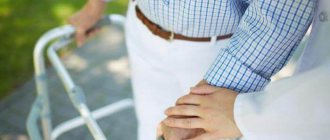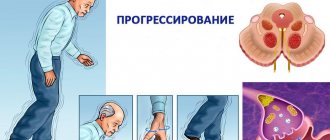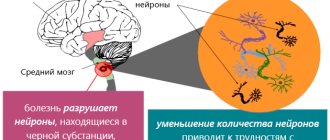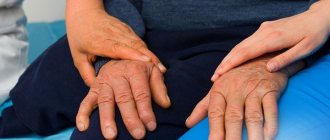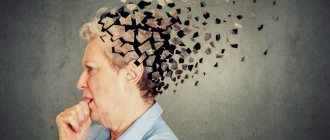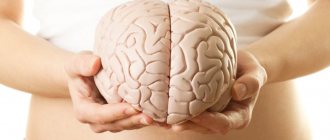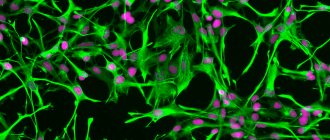The causes of Parkinson's disease are those factors that influence the occurrence and development of this disease throughout human life. Typically, this disease is chronic; as the pathology develops, permanent degenerative changes occur in the body as a result of the death of brain cells.
The reasons why these processes occur have not been fully studied to this day. Medicine at this stage can only talk about those factors that directly or indirectly influence the development of Parkinson's disease. They are considered to be the causes of this disease. In order to more accurately begin to talk about what provokes parkinsonism in a particular case, it is necessary to understand the basis of the pathology and how it affects the processes in the human brain.
Death and damage to dopaminergic cells
Content:
- Death and damage to dopaminergic cells
- Heredity in parkinsonism
- Genetic predisposition
- Brain injury
- Brain diseases
- The presence of harmful and lack of beneficial substances
- Spiritual reasons
Typically, the pathology manifests itself in the fact that in the midbrain the composition of the black substance begins to actively change. This substance in its normal state contains cells capable of producing the substance dopamine. Dopamine is necessary for the connection of nerve processes or neurons of the substantia nigra with the striatum of the brain. With a lack of dopamine, a disturbance in the coordination of movements occurs, motor ability decreases, all this progresses until the person completely loses his ability to work and independence. The synthesis of dopamine decreases, and as a result, the neurotransmitter function with which a person coordinates his own movements decreases.
When dopaminergic cells in the brain are damaged or killed, dopamine production drops sharply, which leads to a lack of interaction between the substantia nigra and the striatum in the human brain. When 80% of dopaminergic cells are lost, symptoms of Parkinson's disease begin to appear. As their synthesis in the body decreases, the disease progresses to more complex stages.
Experts still cannot accurately answer the question about the causes of damage and death of nerve cells that provoke parkinsonism. According to experts at the University of Cambridge, genetic mutations that undermine the natural process of rejecting defective mitochondria may be to blame for this process. As you know, mitochondria act as a kind of battery for the cell, destroying and creating energy for them. If defective mitochondria are detected, they need to be eliminated. However, there are defects in the genetic code of Parkinson's disease that interfere with the process of repairing mitochondrial defects. This study suggests that if patients are given medications to remove unnecessary mitochondria during therapy, the development of parkinsonism can be prevented.
What is Parkinson's disease
The disease is named after the remarkable English physician James Parkinson, who showed phenomenal clinical observation and was able to describe almost all the main signs of the disease in “An Essay on Shaking Palsy,” published in 1817. The name “shaking paralysis” reflected the paradoxical combination of excessive violent movements with a peculiar “weakness” - disturbance of fine movements of the limbs, stiffness, general slowness and impoverishment of the pattern of movements.
Today, doctors know that the disease is based on dysfunction and a decrease in the number of large cells containing the black pigment neuromelanin and producing dopamine. These cells are concentrated in the brain in an area called the substantia nigra. Actually, their accumulation gives this structure a dark shade, reflected in its name. The dopamine released by these cells, which serves to transmit excitation from one cell to another, maintains the entire system of subcortical structures, united by close bilateral connections, in a working, active state.
Lack of dopamine in the deep (subcortical) parts of the brain is a key biochemical defect in Parkinson's disease. The main motor manifestations of the disease are associated with it, and correction of dopamine deficiency with the help of levodopa and other dopaminergic drugs is the main direction in its treatment.
Parkinsonism syndrome with similar symptoms is also possible with vascular or traumatic damage to the subcortical structures of the brain, brain tumor, dilation of the ventricles of the brain (hydrocephalus), side effects of medications, and some other chronic diseases of the brain.
However, Parkinson's disease is the most common cause of parkinsonism syndrome, accounting for up to 80% of its cases. In general, the prevalence of Parkinson's disease is about 140 cases per 100,000 population. Basic information about Parkinson's disease 9 and at least 2% of people over the age of 75 suffer from it. Parkinson's disease most often manifests itself after 50 years, but cases of the onset of the disease at an earlier age are not uncommon. Men are affected somewhat more often than women.
In recent years, it has become known that the cause of the pathology of the cells of the substantia nigra is the excessive accumulation of the alpha-synuclein protein due to its increased production (in a few genetically determined cases of the disease) or a violation of its breakdown. Deposits of alpha-synuclein in cells form intracellular Lewy bodies, which serve as one of the most important pathomorphological markers of the disease detected postmortem.
In approximately 5–10% of cases, Parkinson's disease is familial, indicating that it may be due to a genetic defect that appears in adulthood, but this has so far been identified in only a very small number of cases. It is assumed that sporadic cases occurring in the absence of a family history (i.e., relatives suffering from the same disease) are caused by an as yet unidentified external factor that manifests its effect in individuals with a hereditary predisposition.
A hereditary predisposition may involve a deficiency in systems that prevent the accumulation of alpha-synuclein and other intracellular proteins in nerve cells or their damage during oxidative processes.
It has been noted that the disease is more common in non-smokers, but it remains unclear whether this fact is explained by the protective role of smoking or by the fact that in people with a predisposition to Parkinson’s disease this certainly bad habit is not developed as actively. The disease often manifests itself after psychoemotional stress, but its role has not been fully determined.
The main clinical manifestation of Parkinson's disease is parkinsonism syndrome, which includes a complex of the following symptoms: • slowness of all movements; • violation of fine movements of the limbs; • exhaustion of rapid alternating movements of the hands and feet; • stiffness (increased tone) of muscles (muscle rigidity); • trembling of the arms and legs (but almost never of the head), which is most pronounced at rest; • instability when changing body position and changing posture (most often - hunching); • shortening of step length and shuffling when walking, lack of friendly movements of the arms when walking.
Symptoms of the disease develop gradually. Trembling, stiffness or awkwardness in one of the limbs usually appears first; less often, the disease initially manifests itself as a change in gait or general stiffness.
At the onset of the disease, attention is often drawn not so much to the limitation of movements as to pain and tension in the muscles of the limbs or back (one of the common misdiagnoses in patients with initial manifestations of Parkinson’s disease is periarthritis of the glenohumeral spine).
Initially, symptoms occur on only one side of the body, but over time they gradually become bilateral. Movements become more and more slow, facial expressions weaken. Due to the rare blinking, the gaze seems piercing, prickly. Friendly movements disappear (for example, hand movements when walking). Fine movements of the fingers are difficult (for example, when buttoning buttons, threading a needle, searching for keys in a pocket, playing musical instruments). Handwriting becomes smaller and less legible. It becomes more and more difficult for the patient to change his position, for example, to get up from a chair or turn in bed from side to side. Speech becomes muffled and monotonous, sometimes stuttering. The gait changes: steps become shorter, shuffling. On the affected side, the patient is forced to drag his leg. Due to the predominance of the tone of the flexor muscles, the head and torso of patients bend forward, the arms are bent at the elbows and pressed against the body, the legs are bent at the knees (“supplicant pose”).
Trembling (tremor) usually occurs at rest, for example, in a hand resting quietly on a knee or leg when the patient is sitting and not leaning on it. In addition to the extremities, tremors often involve the lower jaw and lips, but rarely the entire head. The movements of the thumb and index finger during parkinsonian tremor resemble “rolling pills” or “counting coins.”
Trembling is an extremely dynamic symptom and depends both on the emotional state of the patient and on his movements. For example, a tremor in an arm decreases or disappears during its movement, but increases with movements of the other arm or legs (including when walking). Trembling is usually very disturbing to patients, because, as they believe, it attracts the attention of others to them and “gives away” their illness. However, in contrast to hypokinesia and rigidity, typical resting tremor practically does not interfere with their motor activity, since it weakens or even completely disappears when moving. Only in some patients it persists during movements and can make them difficult.
The condition can fluctuate significantly during the day or from day to day, often depending on psycho-emotional and, possibly, external (weather) factors. Due to the shyness and feeling of awkwardness that the patient experiences when surrounded by unfamiliar people (for example, on public transport), feelings of anxiety, stiffness and trembling may increase. On the contrary, when you are with your family, among good friends, and have the opportunity to do what you love, physical activity becomes much easier. For example, musicians suffering from Parkinson's disease note that their condition improves after invitingly tapping the conductor's baton on the music stand before the start of a performance. According to the famous literary critic and master of artistic storytelling I.L. Andronikov, famous for his oral stories and also suffering from Kinson's disease, his symptoms suddenly decreased as soon as he came under the spotlight on the stage.
In addition to the listed movement disorders, Parkinson’s disease causes “non-motor” disorders of the internal organs: intestinal activity slows down, which leads to constipation, but the bladder disinhibits, and urination becomes more frequent, especially at night. When standing up or staying in an upright position for a long time, and sometimes after eating, blood pressure may decrease, which is accompanied by a feeling of sudden weakness or dizziness.
Concentration during intellectual work can be very difficult. It takes extra effort to remember the right word, which sometimes spins on the tip of the tongue, but does not “pop up”. Salivation increases, including at night - patients often notice wet spots on the pillow already at the onset of the disease.
The person often becomes more anxious and irritable. Often there are long periods of depressed mood – depression. This is due to two reasons: firstly, the patient is upset that he cannot function as fully as before, either at work or at home; secondly, the activity of those parts of the brain that ensure a person’s balanced mood is disrupted. Manifestations of depression are varied and include not only bad mood, but also unusually rapid fatigue, increased irritability or indifference to others, and changes in appetite.
Difficulties arise in relationships with others. This primarily concerns family relationships. Patients are dissatisfied with themselves and the people around them. If both the patient himself and the people around him know about such psychological manifestations of the disease, then this alone helps to relieve psychological stress and establish friendly relationships.
Heredity in parkinsonism
According to many studies, it has been found that Parkinson's disease also has a hereditary cause. If you carefully study your family history, you can identify signs of a gene mutation, although scientists have not yet been able to identify the gene itself. The inheritance pattern of this disease has also not been identified to date, so heredity is still only an assumption in the theory of the development of Parkinson's disease.
It is believed that the most likely type of inheritance of parkinsonism is autosomal dominant. This type suggests that in each generation the manifestation of Parkinson's disease will be noticeable. However, the likelihood of an autosomal recessive mode of inheritance is also high. He says that the disease is inherited through several generations. Men are more often affected by this disease. In order to determine a more accurate mode of inheritance, many tests were carried out, as a result of which experts began to doubt the hereditary factor in the occurrence of the disease in principle. Based on the results of the research, it turned out that only in 5% of cases of Parkinson’s disease there is a related predisposition to the disease.
Genetic predisposition
From assumptions about the hereditary factor of parkinsonism, there follows an assumption about a person’s genetic predisposition to this disease. Parkinson himself suffered from this pathology, along with several other members of his family. Various studies over different periods of time have confirmed the likelihood of a genetic factor as the cause of the disease in the range from 2.5 to 94.5% of all cases of the disease. Such a scatter could not but cause disagreements among neurologists around the world regarding their view of the issue being studied.
The basis of such disagreements is the fact that parkinsonism syndrome may be part of the clinical picture of other neurological pathologies with a hereditary nature of transmission.
Parkinsonism is most often detected in elderly people, to which not all relatives live.
In addition, in the absence of exogenous factors, some metabolic disorders caused by parkinsonism may not appear at all. Therefore, the use of clinical data to establish a genetic predisposition to Parkinson's disease does not allow us to draw reliable conclusions about the causes of the disease.
Less often in medical circles you hear about a recessive type of genetic predisposition to Parkinson's disease, linked to sex characteristics. However, any study reveals a genetic predisposition to the disease in no more than 3-8% of cases. At the same time, this pattern turns out to be different in populations of different countries. It is important to mention here that in Sweden a pattern of predominance of the so-called 0 blood group in patients with parkinsonism has been identified. The same trend is emerging in Norway, but in Finland it is completely absent. Therefore, experts conclude that a possible cause of parkinsonism is the hereditary transmission of a defect in the tyrosine hydroxylase fragment.
4. Treatment of the disease
How to treat Parkinson's disease?
In fact, there is currently no cure for Parkinson's disease.
But there are various medications that can control the symptoms of the disease
and make life easier for a person with such a diagnosis.
If the symptoms of the disease are mild, medication may not be necessary. Typically, various medications are prescribed when the disease begins to interfere with your daily life. To monitor your health, you will need to undergo regular examinations by a good neurologist.
In addition to medications, in some cases Parkinson's disease is treated using so-called deep brain stimulation.
. To do this, wires placed by the surgeon in the brain send small electrical impulses to the part of the brain that controls movement. These little signals can help the brain work better.
There are some things you can do at home to help you stay independent and healthy. Proper nutrition, timely rest and reasonable expenditure of energy, as well as moderate physical activity, as a rule, produce a positive effect. Physical therapy may also help.
How does Parkinson's disease affect your life?
A diagnosis of Parkinson's disease, a progressive disease, can change your life and cause severe anxiety and depression. But it's worth keeping some facts in mind:
- No one can predict in advance how the disease will develop. But usually the disease progresses slowly. Some people live for years with only minor symptoms, such as tremors in one arm.
- Many people with Parkinson's disease can and do continue to work for many years.
- It is important to be very careful when treating the disease. Find a good doctor you can trust and follow all his treatment recommendations.
Brain injury
Even the mildest single brain injury can increase the likelihood of developing neurodegenerative diseases, including Parkinson’s disease, as American doctors have repeatedly stated. Neurologists trace the relationship between any concussion and the occurrence of senile dementia, based on a study of 300 thousand older Americans over 12 years. Data showed that when patients suffer brain injuries, they develop parkinsonism in 71% of all cases of the disease. Moreover, out of 300 thousand case histories, half contained records of tuberculosis incidence.
Doctors noted that when suffering a moderate concussion, the risk of developing pathology is about 56%, and when suffering a concussion along with tuberculosis - 83%. Experts suggest that a concussion reduces the resistance of this organ to the factors of aging. Along with mechanical concussion, depressive states also have a negative impact on the stability of the human brain, which has been proven by Canadian scientists.
Brain diseases
Another factor that can provoke the occurrence and development of Parkinson’s disease is a number of diseases and their complications in the human brain. Often, after suffering viral or infectious processes in the brain, complications can occur, for example, meningitis, encephalitis and others. These infectious processes weaken the immune system, can destroy brain cells and, as a result, lead to secondary parkinsonism.
Pathology can be caused by various vascular diseases, for example, atherosclerosis of blood vessels, circulatory disorders in the body. Tumors in the brain area can also play an important role in the development of Parkinson's disease.
The presence of harmful and lack of beneficial substances
With severe intoxication in the body, brain tissue is poisoned by toxins, which also sometimes causes a pathological process. The occurrence and development of Parkinson's disease can be influenced by poisoning with manganese, heavy metals, drugs, carbon monoxide and other substances. A striking example of the occurrence of Parkinson's disease in young people is the discovery of a massive incidence of this disease in 1977 among a group of young people who used synthetic heroin.
There is no direct relationship between the incidence of Parkinsonism and alcohol consumption, but in medical circles it is believed that alcohol abuse, as well as drugs, provokes weakening of brain cells and creates a favorable environment for the development of Parkinson's disease.
Sometimes the disease can be caused not only by the presence of harmful substances in the human body, but also by insufficient levels of beneficial ones, for example, vitamin D deficiency. Vitamin D in the human body is responsible for the formation of a protective barrier aimed at combating free radicals and toxins. Therefore, with its deficiency in old age, all of the above substances freely enter the brain and have a detrimental effect on its cellular structure, which is a prerequisite for the occurrence of Parkinson’s disease.
Best materials of the month
- Coronaviruses: SARS-CoV-2 (COVID-19)
- Antibiotics for the prevention and treatment of COVID-19: how effective are they?
- The most common "office" diseases
- Does vodka kill coronavirus?
- How to stay alive on our roads?
Diagnostics
At the initial appointment, the doctor at the Medica24 International Clinic asks the patient (or his relatives) about the symptoms, the time of their appearance, the dynamics of development, as well as the presence of diseases in the family. This is called taking a personal and family history.
After this, the doctor conducts an external examination, paying attention to violations of coordination, movements, body posture, and uses several tests to assess the degree of rigidity, akinesia (for example, a test for clenching and unclenching a fist, etc.).
When diagnosing, the doctor must differentiate Parkinson's disease from many neurological disorders by the presence of strokes, antipsychotic therapy, the presence of long-term remissions (Parkinson's disease develops without remissions), traumatic brain injuries, a history of encephalitis and a number of other signs.
After establishing a preliminary diagnosis, if Parkinson's disease is suspected, the doctor will refer the patient for additional examinations.
1. Rheoencephalography.
This is a research method using a weak high-frequency electric current that shows the nature of blood circulation in the brain.
2. Electroencephalography.
EEG helps to assess the general and local functional activity of the brain and identify pathological foci.
3. Computed tomography.
A CT scan of the brain gives a detailed picture of blood circulation, the condition of the nervous tissues of the brain, and helps to detect pathological areas and tumors.
4. Magnetic resonance imaging.
MRI of the brain is performed using a magnetic field and, unlike CT, does not expose the brain to radiation. Therefore, this type of examination can be carried out many times. MRI helps to examine in detail the state of the nerve tissue of the brain and detect areas of neuronal damage.
Along with these basic diagnostic methods, laboratory tests are used, and, if necessary, other high-tech, modern examinations, which allow her not only to clarify the diagnosis, but also to determine the best treatment tactics.

